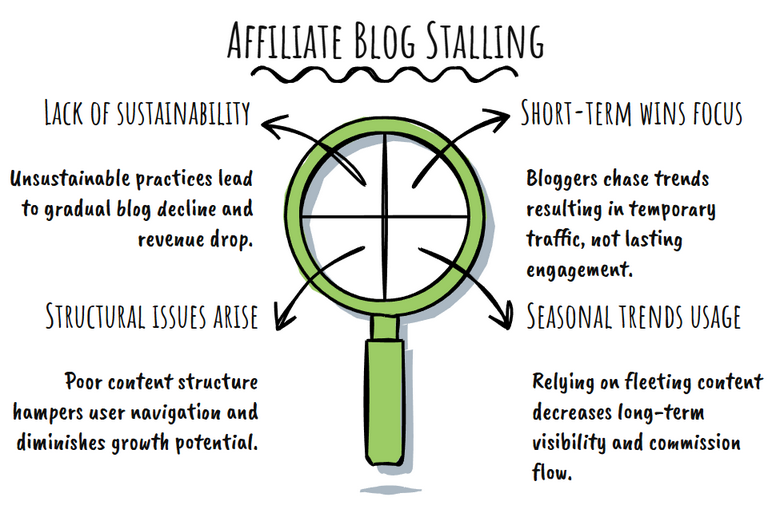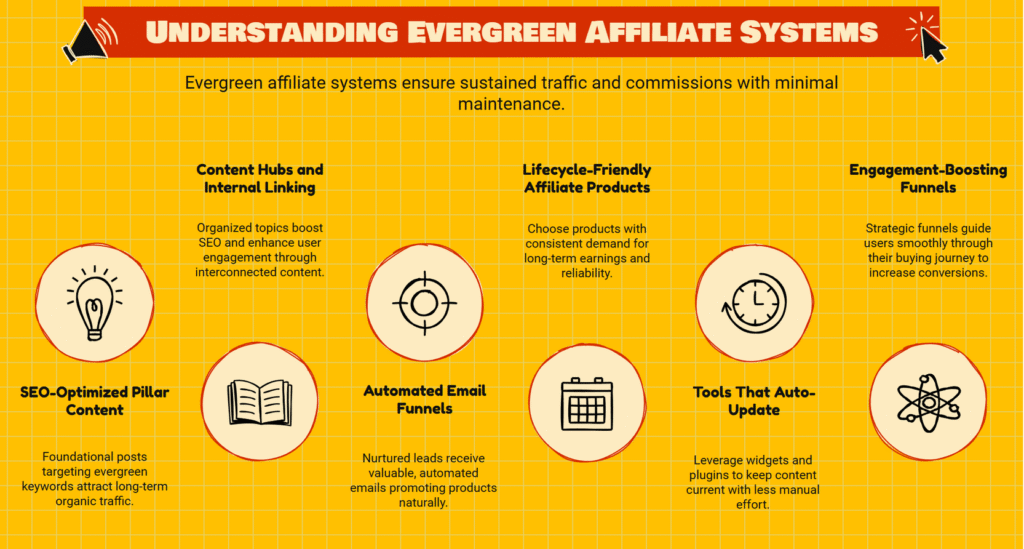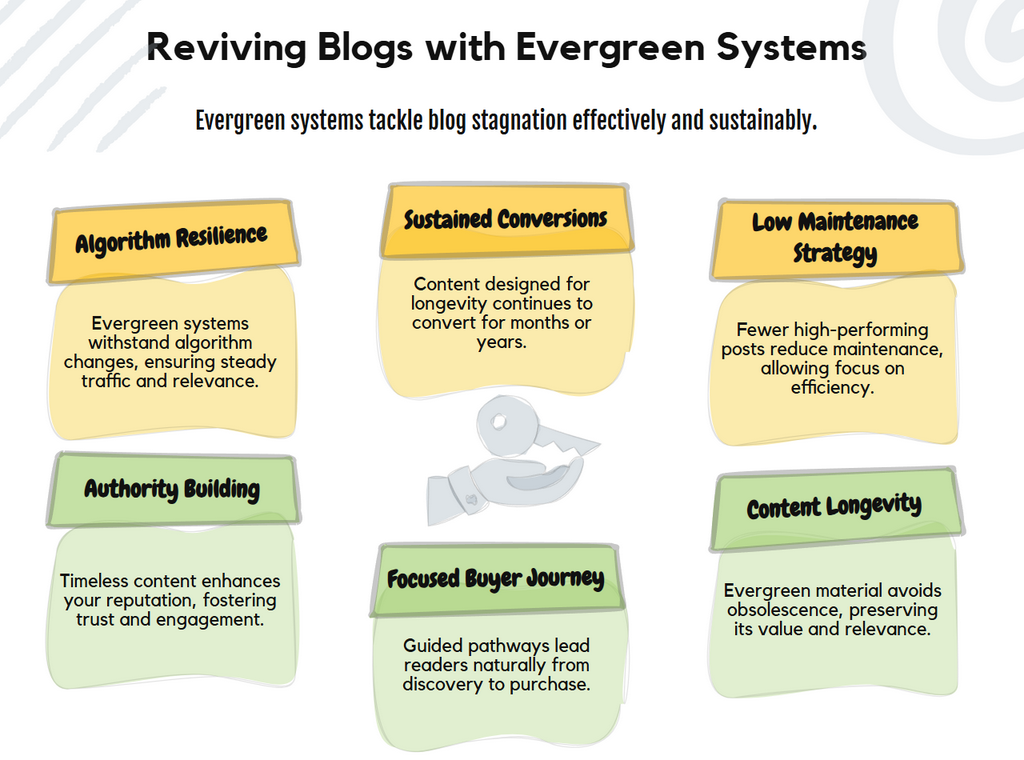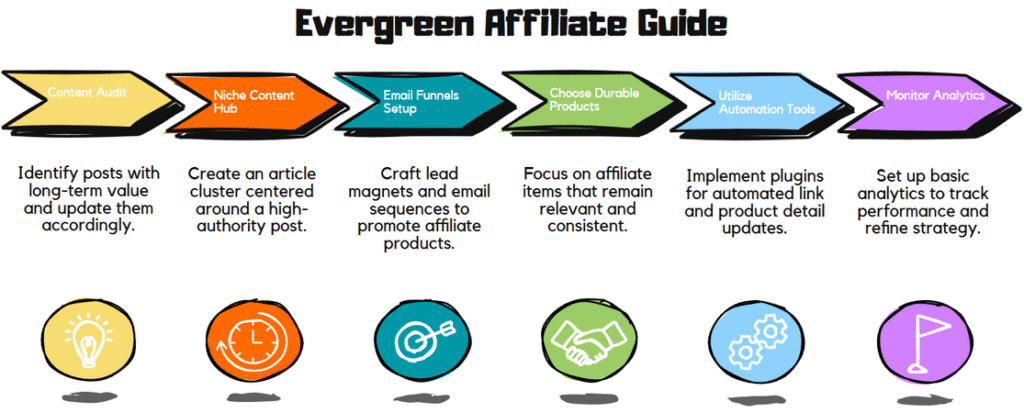
If you’re frustrated by unpredictable traffic and fading commissions, evergreen affiliate systems might be the breakthrough you’ve been missing. Most affiliate blogs stall—and not because of a lack of effort.
You pour hours into writing posts, hunting for profitable keywords, and sharing on social. But after a brief spike, your content drops off the radar. The result? Stalled growth, disappearing rankings, and income that dries up faster than you can publish new content.
The truth is, without a repeatable, scalable system, your affiliate blog is built on a shaky foundation. In this post, you’ll learn why most affiliate blogs flatline and how evergreen affiliate systems provide a sustainable engine for long-term revenue, visibility, and freedom.
The Hidden Reason Most Affiliate Blogs Stall

Affiliate blogs don’t fail overnight—they fade. The root cause? A lack of sustainability. Most bloggers focus on short-term wins: chasing viral topics, launching trend-based content, and reacting to the latest algorithm shifts. While this might deliver a temporary traffic surge, it rarely lasts.
Affiliate content often relies on product launches, seasonal trends, or fleeting keywords. These create spikes, not streams. Once the buzz fades or the product becomes outdated, so does the post—and with it, your commission flow.
Another issue is structure. Without a system in place to guide users through a buyer journey, even well-written posts become standalone islands. There’s no compounding growth, no content ecosystem, and no real momentum.
Ultimately, these blogs become a treadmill of effort with diminishing returns. The solution isn’t more content—it’s smarter content supported by systems built to last.
Algorithm Dependence
Many affiliate bloggers unknowingly tie their success to the whims of search engine algorithms. They optimize posts to ride algorithm trends—prioritizing freshness, keyword density, or E-A-T (Expertise, Authoritativeness, Trustworthiness). But when the algorithm shifts, so does their traffic.
Google updates, such as core algorithm rollouts or product review guidelines, can wipe out rankings overnight. Blogs built without a resilient content strategy often have no buffer. Traffic tanks, and income follows.
Short-term tactics—like targeting only trending keywords or relying on aggressive backlinking—aren’t enough to maintain stability. When the blog’s visibility relies solely on staying in Google’s good graces, one change can undo months of work.
This is where evergreen affiliate systems shine. They decouple your success from algorithm volatility by creating timeless content structures, diversified traffic channels, and systems that continue converting visitors long after they land on your page.
Burnout from Manual Content Maintenance
Affiliate blogging isn’t just about creating content—it’s about maintaining it. And that’s where many bloggers hit a wall.
Every product update, price change, or policy shift requires edits across dozens of posts. Outdated reviews and broken affiliate links don’t just kill conversions—they damage trust. The problem is, most bloggers don’t have a system to manage this upkeep efficiently.
What starts as a passion project quickly becomes a time sink. Instead of scaling your income, you’re trapped in a cycle of reactive maintenance. The workload grows, the excitement fades, and burnout sets in.
This is another reason affiliate blogs stall—not from lack of talent, but from overwhelming upkeep. Evergreen affiliate systems alleviate this by automating updates, streamlining workflows, and focusing on content that remains relevant and profitable with minimal intervention.
What Are Evergreen Affiliate Systems?

Evergreen affiliate systems are frameworks designed to generate consistent traffic, engagement, and commissions—without constant intervention. Unlike short-lived tactics that require frequent updates, these systems focus on long-term sustainability and automation.
At their core, evergreen systems rely on content that stays relevant over time—answering timeless questions, solving recurring problems, and promoting products that don’t go out of style. But content is just one part of the equation.
An evergreen affiliate system also includes strategic structure: optimized internal linking, conversion-boosting funnels, automated email sequences, and intelligent keyword targeting. These pieces work together to keep users engaged, guide them through the buyer’s journey, and increase conversions—even while you sleep.
Let’s break down what these systems look like in practice.
Core Components of Evergreen Affiliate Systems
To build a truly effective evergreen affiliate system, you need more than just timeless content—you need a smart structure that works together seamlessly. Here are the core components that make it all click:
1. SEO-Optimized Pillar Content
These are in-depth, authoritative posts that serve as the foundation of your site. They target high-volume, evergreen keywords and act as entry points for long-term organic traffic. Examples include ultimate guides, “best of” lists, and detailed how-to articles.
2. Content Hubs and Internal Linking
Rather than isolated blog posts, evergreen systems organize content into clusters or “hubs.” Each hub revolves around a central pillar topic with supporting articles that link to one another—boosting SEO and keeping users engaged longer.
3. Automated Email Funnels
After capturing a visitor’s email, an evergreen system nurtures that lead through automated sequences. These emails deliver value, build trust, and promote affiliate products in a way that feels natural, not spammy.
4. Lifecycle-Friendly Affiliate Products
The best products for evergreen systems have staying power—no limited-time launches or fads. Think SaaS tools, hosting plans, or physical products with consistent demand and recurring commissions.
5. Tools That Auto-Update
Widgets, comparison tables, or plugins that auto-pull product data (like pricing and availability) drastically reduce the need for manual updates, keeping your content fresh and trustworthy.
When combined, these components create a system that attracts, engages, and converts—without requiring you to be in constant content creation mode.
How Evergreen Affiliate Systems Solve Blog Stagnation

When affiliate blogs stall, it’s rarely due to a single issue—it’s a combination of declining traffic, outdated content, and inconsistent conversions. Evergreen affiliate systems are built to address all of these problems at once, offering a scalable solution that keeps working long after the initial setup.
1. Resilience Against Algorithm Updates
By focusing on evergreen content and solid site architecture, these systems are less dependent on volatile algorithm changes. Your traffic doesn’t collapse every time Google tweaks its formula because your content is built on relevance, not recency.
2. Low Maintenance, High Leverage
Instead of constantly updating dozens of outdated posts, you maintain a smaller number of high-performing assets. Tools like auto-updating product tables or evergreen email campaigns minimize the manual workload while keeping everything running smoothly.
3. Consistent Conversions Over Time
Because evergreen systems are designed with the buyer’s journey in mind—from discovery to conversion—they guide readers naturally toward affiliate offers. And since the content doesn’t become obsolete quickly, it continues converting months (or even years) after publication.
4. Builds Authority and Trust
Regular, timeless content builds your reputation as a go-to source in your niche. With internal linking and value-driven funnels, readers stay longer, engage more, and trust your recommendations—making them more likely to click and buy.
With these advantages, evergreen affiliate systems not only revive stalled blogs—they create a foundation for reliable, long-term income.
Real-World Case Study: From Stagnation to Scale

Meet Jason, a health and wellness blogger who built an affiliate site focused on trending diets and product reviews. His initial growth was fast—traffic surged, commissions rolled in, and he felt unstoppable. But within a year, the diet trends faded, his rankings dropped, and income plummeted.
Frustrated, Jason turned to evergreen affiliate systems, similar to what I teach in the Snowball Affiliate course.
He started by identifying high-potential, evergreen topics like “how to build a sustainable meal plan” and “best supplements for long-term health.” He created in-depth pillar posts, clustered related content around them, and linked internally to guide readers through a helpful journey.
Next, he set up automated email funnels offering a free meal planner in exchange for an email address—then promoted long-term products like supplements and meal prep services with recurring commissions.
Within six months, Jason’s traffic rebounded—and this time, it didn’t spike and crash. His income stabilized, his content required minimal upkeep, and most importantly, he was no longer chained to publishing weekly just to stay afloat.
His blog became an asset, not a burden.
Implementing Evergreen Affiliate Systems Step-by-Step

Ready to stop spinning your wheels and build something that lasts? Here’s a simple, actionable roadmap for implementing evergreen affiliate systems on your blog.
Step 1: Audit Existing Content for Evergreen Potential
Start by identifying which of your current posts have long-term value. Look for timeless topics, consistent traffic, and affiliate products with staying power. Update or repurpose them into cornerstone content.
Step 2: Create a Content Hub Around a Profitable Niche
Pick a niche with steady demand and build a cluster of related articles around one high-authority pillar post. Use strategic internal linking to guide readers deeper into your content ecosystem.
Step 3: Build Evergreen Email Funnels
Offer a free lead magnet (like a checklist or mini-course) tied to your core topic. Then, create a 5–7 email sequence that delivers value and gently promotes relevant affiliate products. Use tools like ConvertKit, ActiveCampaign, or MailerLite for automation.
Step 4: Promote Lifecycle-Friendly Products
Focus on affiliate products that don’t expire, change frequently, or rely on seasonal demand. SaaS tools, educational courses, and evergreen physical products are ideal for long-term income.
Step 5: Use Tools to Automate and Monitor
Incorporate affiliate plugins (like Lasso, AAWP, or ThirstyAffiliates) that automatically update links, pricing, or product details. Set up basic analytics to monitor performance and refine over time.
By following these steps, you’ll create a system that not only grows but sustains itself—freeing you from the constant content hamster wheel.
Final Thoughts: Future-Proof Your Affiliate Income
Affiliate blogging doesn’t have to be a grind. If your income feels like a rollercoaster—booming one month and crashing the next—it’s not your fault. The problem isn’t you. It’s the system (or lack of one).
Evergreen affiliate systems offer a smarter way forward. They allow you to create lasting assets, not fleeting wins. Instead of constantly chasing trends, you’ll build a content engine that works around the clock—bringing in traffic, nurturing leads, and driving commissions on autopilot.
By focusing on timeless content, smart automation, and product strategies built for longevity, you’re not just building a blog—you’re building a business.
Now is the time to stop patching holes in a sinking ship and start designing a system that grows stronger over time.
